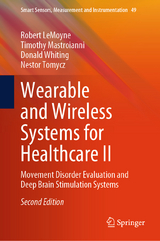
Wearable and Wireless Systems for Healthcare II
Springer Verlag, Singapore
978-981-13-5807-4 (ISBN)
- Titel erscheint in neuer Auflage
- Artikel merken
Dr. Robert LeMoyne is currently serving as an Adjunct Professor for Northern Arizona University for the Department of Biological Sciences and Center for Bioengineering Innovation. At Northern Arizona University he is researching advanced technology concepts for wearable and wireless systems for biomedical applications. He earned his PhD in Biomedical Engineering from University of California Los Angeles (UCLA) during 2010. From 2010 to 2012 he served Sandia National Laboratories, and since 2013 he has been serving Northern Arizona University. Dr. LeMoyne has first authored over 100 technical proceedings that have been cited over 1000 times. From a biomedical engineering perspective his research interests emphasize deep brain stimulation systems, prosthetic technologies, machine learning applications, and wearable and wireless systems for biomedical applications, such as through smartphones and portable media devices, for accessing health status, such as Parkinson’s disease and Essential tremor. Timothy Mastroianni is a Cognitive Scientist, Researcher, Entrepreneur. First to develop and use computer vision and pattern recognition in a non-invasive manner to discover the internal states of the random number generator in machines (HiLoClient). Later presented these algorithms and methods to Carnegie Mellon University to map the human brain using machine learning and fMRI to discover brain states during specific tasks. Nestor D. Tomycz MD was born and raised in Flint, MI. He graduated from Harvard College summa cum laude in chemistry in 2001 and earned his MD from Harvard Medical School in 2005. His general surgery internship and neurosurgery residency were completed at the University of Pittsburgh Medical Center and he completed a fellowship in functional and stereotactic neurosurgery at Allegheny General Hospital under Dr. Donald Whiting. He is currently director of stereotactic/functional neurosurgery and director of neurosurgical pain division at Allegheny General Hospital. His research interests include deep brain stimulation, spinal cord stimulation, chronic pain, and neurodegenerative disorders. Donald Mark Whiting was raised in Altoona, Pennsylvania and began his undergraduate education at Grinnell College in Iowa in 1976. He received an MS in Physiology at Georgetown University in 1981 and was awarded his medical degree in 1985 after training at Thomas Jefferson Medical College in Philadelphia. Donald then completed his neurosurgical residency at The Cleveland Clinic and a Neurotrauma fellowship at Allegheny General Hospital. In 1992, Donald Whiting joined a practice in Washington, PA that would later merge with the health system now known as Allegheny Health Network. He became the System Chair for their Neuroscience Institute and a Professor of Neurosurgery for Drexel University in 2014. Three years later, he also accepted the role of Presidentof Allegheny Clinic. Amongst his peers, Donald Whiting is a respected physician-leader that is passionate about changing the way health care is delivered. Donald has authored over 60 scientific articles and chapters in medical textbooks and various publications such as The Journal of Neurosurgery & Current Concepts in Movement Disorder Management. He is an active member in many of his field’s leading professional and scientific organizations, including the Congress of Neurological Surgeons, the American Association of Neurological Surgeons, and the American Society of Stereotactic and Functional Neurosurgery. It’s no wonder Donald Whiting has been the annual recipient of “Top Doctor/Surgeon” awards on both local & national levels. He is regarded as one of the nation’s foremost experts in the use of deep-brain stimulation to control the debilitating motor symptoms of patients with Parkinson’s disease and other movement disorders, helping establish Allegheny General Hospital in Pittsburgh, Pennsylvania as one of the top centers in the world for DBS treatment. His sub-specialties include complex spine surgery, disc replacement/motion preservation spine surgery, the surgical treatment of movement disorders & Neurosurgical management of pain. In his spare time, he enjoys spending time with his family, making pizza & wine.
1. Wearable and wireless systems for movement disorder evaluation and deep brain stimulation systems.- 2. Movement disorders: Parkinson’s disease and Essential tremor, a general perspective.- 3. Traditional ordinal strategies for establishing the severity and status of movement disorders, such as Parkinson's disease and Essential tremor.- 4. Deep brain stimulation for the treatment of movement disorder regarding Parkinson's disease and Essential tremor with device characterization.- 5. Surgical procedure for deep brain stimulation implantation and operative phase with post-operative risks.- 6. Preliminary wearable and locally wireless systems for quantification of Parkinson's disease and Essential tremor characteristics.- 7. Wearable and wireless systems with Internet connectivity for quantification of Parkinson's disease and Essential tremor characteristics.- 8. Role of machine learning for classification of movement disorderand deep brain stimulation status.- 9. Assessment of machine learning classification strategies for the differentiation of deep brain stimulation ‘On’ and ‘Off’ status for Parkinson’s disease.- 10. New perspectives for Network Centric Therapy for the treatment of Parkinson's disease and Essential tremor.
| Erscheinungsdatum | 17.03.2019 |
|---|---|
| Reihe/Serie | Smart Sensors, Measurement and Instrumentation ; 31 |
| Zusatzinfo | 52 Illustrations, black and white; XV, 128 p. 52 illus. |
| Verlagsort | Singapore |
| Sprache | englisch |
| Maße | 155 x 235 mm |
| Themenwelt | Medizin / Pharmazie ► Medizinische Fachgebiete ► Neurologie |
| Medizin / Pharmazie ► Physiotherapie / Ergotherapie ► Orthopädie | |
| Studium ► 1. Studienabschnitt (Vorklinik) ► Physiologie | |
| Technik ► Elektrotechnik / Energietechnik | |
| Technik ► Medizintechnik | |
| Technik ► Nachrichtentechnik | |
| Schlagworte | Deep Brain Stimulation • Essential tremor • Parkinson’s disease • Smartphones and portable media devices • Wearable wireless systems |
| ISBN-10 | 981-13-5807-9 / 9811358079 |
| ISBN-13 | 978-981-13-5807-4 / 9789811358074 |
| Zustand | Neuware |
| Haben Sie eine Frage zum Produkt? |
aus dem Bereich



